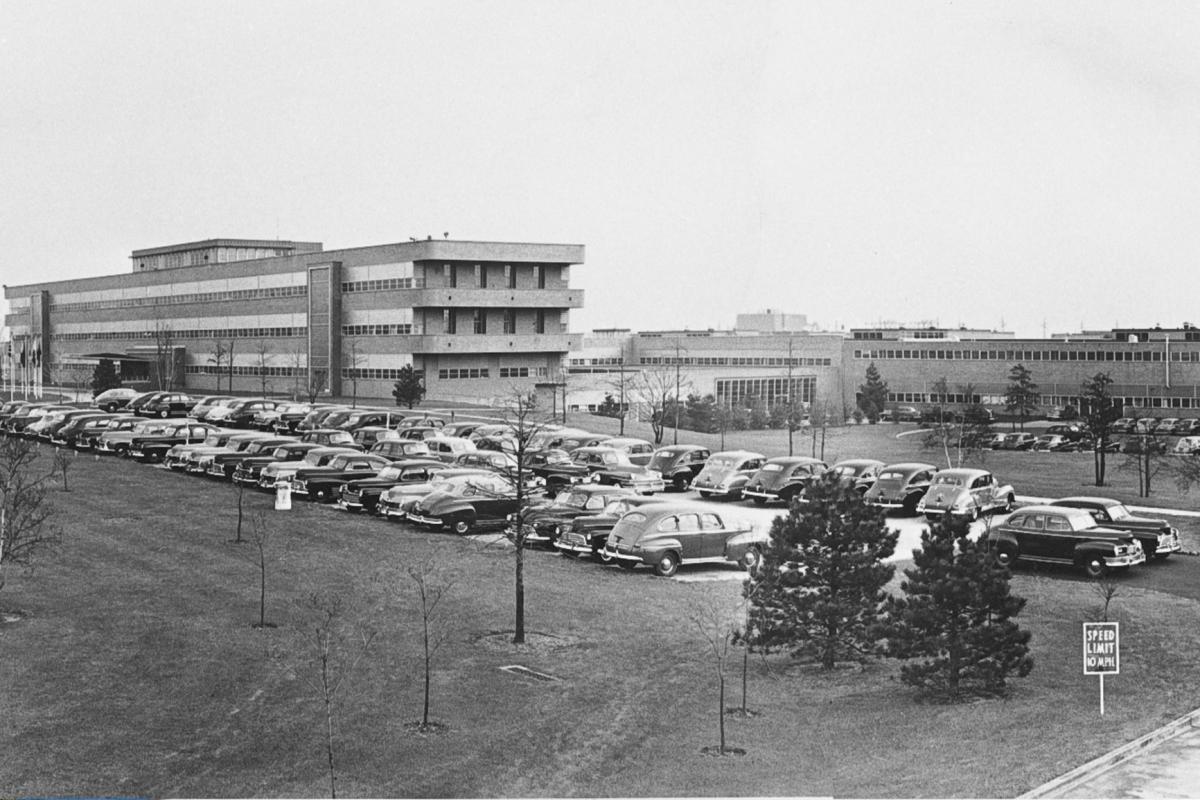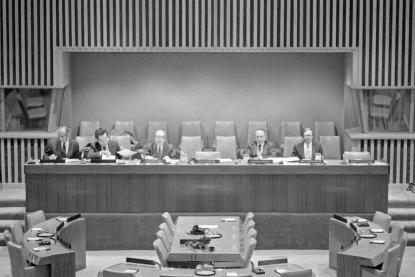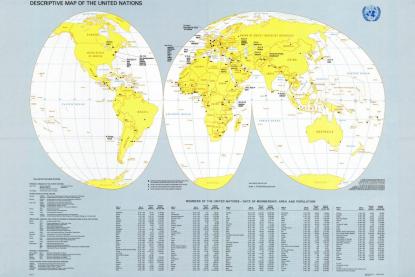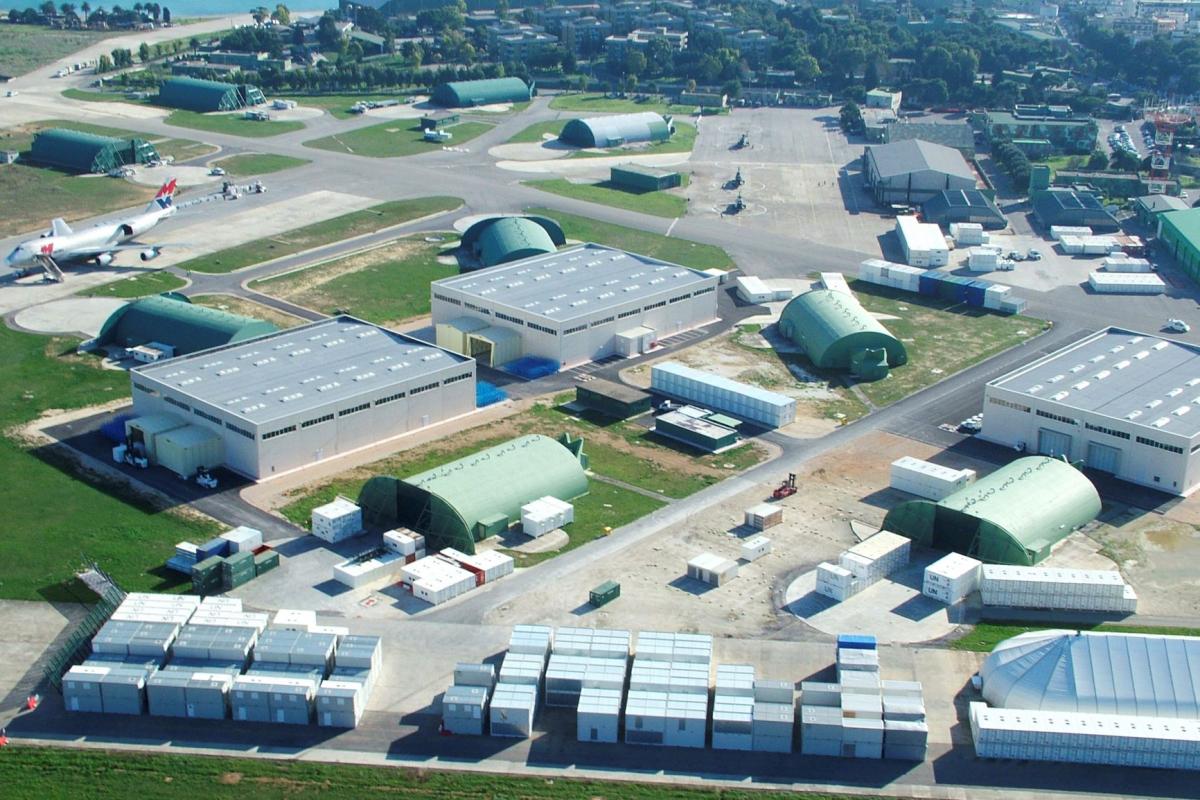History
Pre-United Nations
The League of Nations (1919-1945), predecessor to the United Nations, had the first quasi-map-making unit. The Draughtsmen Service handled queries and requests Secretariat-wide. Graphs and maps were produced on demand to illustrate reports and publications. Reference numbers consisted of an abbreviation of Société des Nations (S.D.N.) along with a unique number.
Beginning of cartography in the Secretariat
 When the United Nations was established in 1945, cartographic materials were prepared by a single staff member attached to the Presentation Section under the Printing Division of the Bureau of Documents of the Conference and General Services. This illustrates that from the beginning, to service the United Nations Secretariat, cartography was an important component of the Organization.
When the United Nations was established in 1945, cartographic materials were prepared by a single staff member attached to the Presentation Section under the Printing Division of the Bureau of Documents of the Conference and General Services. This illustrates that from the beginning, to service the United Nations Secretariat, cartography was an important component of the Organization.
During and after the Second World War, there was an unprecedented interest in map-making. It is not surprising then that shortly after the new United Nations switched into high gear, proposals were submitted by Member States to review the cartographic functions of the Organization. By the beginning of 1947, the Secretary-General had received multiple communications for initiating action to coordinate the work of the United Nations and Specialized Agencies in the field of cartographic services.
In 1948, the Economic and Social Council in resolution 131(VI) recommended that Governments of Member States stimulate surveying and mapping of their national territories and that the Secretary-General of the United Nations take appropriate action to further such efforts. A Committee of Experts on Cartography was appointed by the Secretary-General to study the issue and advise upon a means of implementation.
The Committee sought to answer two questions: first, what should the United Nations do to stimulate and assist Member States in the development of the mapping sciences, and second, what sort of cartographic service did the United Nations need in order to carry out this program, for its own operations, and in its relations with the specialized agencies.
The creation of cartographic offices
In 1951, the Committee stated that "[...] speaking with complete candor, [the Committee is] appalled at the present lack of cartographic service for United Nations activities, and at the failure, thus far, of some element within the United Nations to interpret ... the need of cartographic service in the operations of the United Nations and of its specialized agencies." The developments that followed this momentous meeting set the course for the cartographic program in the United Nations for decades to come. The Secretariat was unsuccessful at establishing a single entity on this matter and as a result, three cartographic functions were established.
A cartographic office dealing with inter-governmental cartographic activities was established under the Department of Social Affairs to support surveying, nautical charting, photogrammetry and mapping projects. The office organized inter-governmental meetings, conferences, seminars, and various training courses.
Separately, a Cartographic Unit was set up in 1951 for the Organization’s own operations which included preparation of original maps related to the work of the Secretariat, formulating cartographic standards and procedures for the Organization, and providing technical advisory services.
Finally, the Map Library collection was created, as a third separate entity, with holdings that include cartographic reference material, atlases, over 80,000 sheet maps, and an extensive collection of geographical names gazetteers.
Changing mandates and activities
 Intergovernmental proceedings
Intergovernmental proceedings
In 1953, at its ninth session, the Economic and Social Council noted the report of the Committee of Experts on Cartography including the convening of regional cartographic conferences and requested the Secretary-General to consult with governments concerning such meetings to which many governments expressed their desire to participate in the conference for Asia and the Far East. The Economic and Social Council, after consideration of this response, adopted resolution 556(XVIII) on 27 July 1954. Later, taking note of the success of the regional cartographic conferences held in the region of Asia and the Pacific since 1955 and the region of Africa since 1963, the Economic and Social Council, at its fifty-sixth session (1974) adopted resolution 1839 (LVI) which "Requests the Secretary-General to make the necessary arrangements to convene the First United Nations Regional Cartographic Conference for the Americas during the first quarter of 1976."
In 1959, the Economic and Social Council paved the way for a small group of experts to meet and provide technical recommendations on standardizing geographical names at the national and international levels. This meeting gave rise to the United Nations Conferences on the Standardization of Geographical Names (UNCSGN) and to the United Nations Group of Experts on Geographical Names (UNGEGN).
Regional Cartographic Conferences and United Nations Group of Experts on Geographical Names continued, both supported by the Statistics Division as its Secretariat, in the Department of Economic and Social Affairs (DESA).
The Map Library
The Map Library collection, geographically comprehensive, includes atlases and maps with thematic topics such as climate, communications, economics, energy, geology, politics, population, and transportation. Generally, topographic maps up to a scale of 1:250,000 are collected, as well as maps of scale 1:50,000 for areas of interest and operations of the United Nations. The collection includes national and regional toponymic gazetteers from other countries and publishers. In 2010, after over 70 years of activity, the Map Library merged with the overall functions of the Dag Hammarskjöld Library of the United Nations.
 Cartographic functions in the Secretariat
Cartographic functions in the Secretariat
In the 1950s, the Cartographic Unit grew to a team of four professional cartographers headed by a Unit Chief. The Unit operated its own computerized typesetting equipment and a darkroom lab used to produce its maps. Between the 1950s and 1970s, a majority of maps produced by the Cartographic Unit focused on general maps of regions of the world, countries especially those which were transitioning from a trusted territory, countries formerly administered by other counties and placed under the administrative authority by the United Nations. to a sovereign territory through independence, and thematic maps in the context of economic and social development. In the 1990s, the now Cartographic Section systematized peacekeeping deployment maps, began providing technical assistance on boundary delimitation and demarcation in the context of mediation in the peaceful settlement of disputes, conflict prevention and resolution, and initiated the cartographic - and later, remote sensing - support to the Security Council and its Panels of Experts.
In the 1990s, with the advent of desktop computers, an increasing number of offices, departments and specialized agencies began producing their own cartographic products, resulting in the issuance of the Administrative Instruction of the Secretary-General concerning the Regulations for the Control and Limitation of Documentation concerning the “Guidelines for the Publication of maps” (revised in 1997) entrusted with the Cartographic Section. Throughout the decades, the Cartographic Section’s organizational setting changed in line with the operational demands of the Organization, societal and technological trends. The Section moved from the Presentation Services (1946) to the Department of Conferences Services (1970s-80s), Department of Public Information (1990s), Department of Peacekeeping Operations (2004), and to the Department of Field Support (2007).
In the 2000s, the Cartographic Section initiated establishment of the United Nations Geographic Information Working Group (UNGIWG) to closely coordinate/collaborate among geospatial information practitioners within the United Nations system (Secretariat, Agencies, Funds and Programmes). In early 2000, the Department of Peacekeeping Operations established geospatial information and remote sensing functions at headquarters and in field missions with an aim to bring geospatial analysis capabilities to peacekeepers, support decision-making and enhance operational awareness. The geospatial peacekeeping capacities were merged into the Cartographic Section in 2005.
Until today
 In 2007, with the ever-increasing demands for up-to-date cartography, topographic mapping, geospatial information, and remote sensing analysis in support of the mandates of the Organization, the Cartographic Section created the GIS Centre at the United Nations Logistics Base in Brindisi (Italy) to increase its capabilities and respond to operational requirements, including in the context of field peace operations and political missions. The geospatial services of what is today the Global Service Centre are key to providing standardized and centralized support to the United Nations Secretariat and its field operations.
In 2007, with the ever-increasing demands for up-to-date cartography, topographic mapping, geospatial information, and remote sensing analysis in support of the mandates of the Organization, the Cartographic Section created the GIS Centre at the United Nations Logistics Base in Brindisi (Italy) to increase its capabilities and respond to operational requirements, including in the context of field peace operations and political missions. The geospatial services of what is today the Global Service Centre are key to providing standardized and centralized support to the United Nations Secretariat and its field operations.
In 2009, discussions were held in New York on how to better coordinate the various regional and global activities on geospatial information management. The Statistics Division and the Cartographic Section convened three preparatory meetings on Global Geospatial Information Management (GGIM): in October 2009, in Bangkok, prior to the 18th UNRCC-AP); in May 2010 (New York); and April 2011 (New York).
In 2011, the Economic and Social Council recognized the need to promote international cooperation in the field of global geospatial information and established the Committee of Experts on Global Geospatial Information Management (ECOSOC Resolution 2011/24). supported by its Secretariat composed of the Statistics Division and the Cartographic Section (para 7). In 2017, the Committee established the United Nations Geospatial Network, consolidating the functions of the United Nations Geographic Information Working Group, and creating a more efficient mechanism to strengthen the coordination and coherence of geospatial information management within the United Nations system.
In 2015, the Cartographic Section was renamed the Geospatial Information Section and in 2019, as part of the Secretary-General’s reforms, the Section moved to the Office for Information and Communications Technology.

